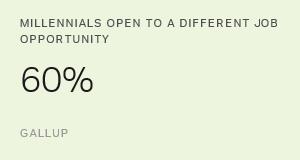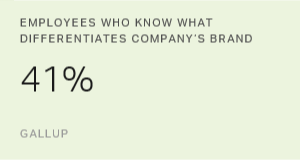Story Highlights
- A majority of Americans say now is a good time to find a quality job
- Companies do a poor job of conveying their brand promise to job seekers
- Organizations need to reach job seekers on an emotional level
Many star employees are probably ready to leave their companies. Is your business prepared to attract them?
Fifty-four percent of Americans say now is a "good time" to find a quality job. This marks the first time a majority has said this since Gallup began tracking the question in 2001. What's more, 51% of U.S. workers overall -- and 60% of millennials -- are considering new employment opportunities.
But companies are doing a poor job of wooing them.
Hoping to attract star employees, companies post job ads with tantalizing perks -- boasting about their exciting opportunities, competitive compensation and flexible environments.
The trouble is, today's job seekers -- particularly job-hopping millennials -- want things that aren't conveyed in typical job postings. They seek companies that feed their desire for meaning and purpose -- and run-of-the-mill job ads and career websites rarely differentiate companies or showcase purpose-centric cultures.
One solution to this problem lies in addressing the disconnect between internal and external branding practices. For many organizations, external branding focuses on conveying brand promises to customers only. Employer branding, on the other hand, is often an HR-led endeavor that treats job seekers more like existing employees than an external audience.
As a result, many companies often communicate compelling brand promises to consumers but fall short of wooing one of the most important groups of customers: the best job candidates.
To remedy this problem, organizations need to promote "employer brand promises." This is because job seekers are both rationally and emotionally motivated. They think not only about things like pay and benefits but also about the organization's purpose and relationships with supportive managers and coworkers. Companies can most effectively communicate employer brand promises by providing emotional interactions and experiences for potential hires.
First Impressions to Star Employees Are Critical
First, leaders need to understand that many prospective employees have already had some sort of interaction with a company before they even consider applying for a job there. For example, an interaction with an appealing product or service, an online review or a referral from a friend may spark a candidate's interest. In these moments workers open up to new information and expectations -- setting their sights on a company as a potentially great place to work.
These first impressions may seem trivial, but they're actually powerful opportunities to reinforce employer brand promises, and they often determine whether talented candidates will seek more information about that company.
Just as car shoppers kick tires, job seekers closely inspect companies -- conducting online research, reading reviews and asking friends for their opinions. These prospective employees picture themselves working for various companies and imagine how each company might fulfill their need for meaning and purpose.
Also similar to car shoppers, people seeking more information about an organization rely on both logic and emotion during this stage of their journey. That is, job seekers employ rational thinking about pay and perks, but they ultimately make selections based on emotion, feeling drawn to companies with a compelling mission and purpose.
Standing Out to Potential Future Employees
The following strategies can help companies stand up to scrutiny from picky job seekers.
Make your pitch on a human level. When crafting career pages, employment ads, job descriptions and recruiting messages, companies should focus on describing the right person for the job -- and how that person would feel working for the company -- rather than simply defining the job itself. Emotionally driven job seekers are attracted to the human aspects of a role and culture, such as the motivations coworkers share or how teams interact. What's more, attracting people who identify with a company's cause helps leaders find perfect-fit candidates who become the most persuasive "brand ambassadors."
Know what makes your company unique. To stand out from the competition, companies need to know what they're up against and capture what makes them stand out. Leaders can glean invaluable intelligence by taking the time to audit the market and review comparable attraction and recruitment efforts (job descriptions, employee testimonials about culture, etc.). In addition, companies should consider how job seekers will compare their employer brand promises with those of other companies.
Infuse your employer brand promise in job seekers' experiences. Companies should leverage every opportunity to illustrate their brand promise throughout potential hires' experiences. For example, a company with a technology-focused brand should ensure candidates experience cutting-edge technology throughout the recruiting process. In addition, building a workforce of brand advocates who share their positive experiences with potential applicants is a winning recruiting strategy to give job seekers a taste of what a company has to offer them.
Bailey Nelson contributed to the writing of this article.





